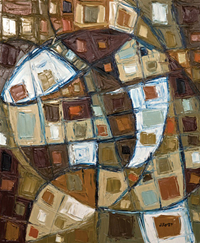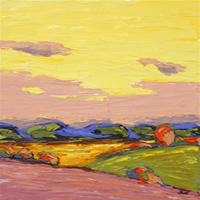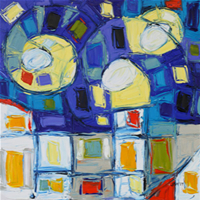|



|
Media -
Oil Paintings
Website - www.jeffferst.com
Email - [email protected]
JEFF FERST BIOGRAPHY
Jeff Ferst paints “geometrical landscapes”, essentially abstract canvases
combining blocks of vivid color and curvilinear forms, out of which emerge elements of nature,
buildings and the human form. Ferst’s paintings are energetic and celebratory, tactile
and visual, grounded in reality and musical in feeling.
Ferst was born in the Bronx in New York City in 1955. As a child, he was involved in drawing
and painting, and through his mother he was exposed to art in New York’s museums. Ferst
went on to major in printmaking (specializing in serigraphs) at New York University,
graduating in 1976. One of his printmaking instructors at NYU was also a textile designer, and
while in school Ferst produced wall hangings of printed fabric, and created a series of
portraits with stuffed fabric on canvas, which he sold through a New York gallery.
From his college days, a group of artists have remained important to Ferst, starting with the
Impressionists, for their focus on intense color relationships. In Kandinsky and Klee, he
found artists who combined an imaginative approach to abstraction with an inventive and
personal feeling for color. In Cubism, Ferst discovered a model for the activated division of
space, which he continues to explore in his current work.
After college, Ferst traveled around Europe and the U.S., eventually settling in Canada in
1978, where he has lived ever since. After running a food company and working in furniture
design, he started producing a series of realistically painted still lifes and landscapes.
These early works, while traditional in subject matter, had a contemporary edge and the
vibrant palette that was to mark Ferst’s later paintings. In this period, he was
exhibiting his work primarily in galleries in Ontario.
In 2005, Ferst experienced a personal and artistic turning point. He survived an episode of
Sudden Cardiac Death, and after emerging from the trauma began to paint again. But the work
that emerged was new to Ferst, completely abstract paintings with vibrant squares of color.
The process of making this emerging work was, in the artist’s words, “natural and
effortless.” These painting have continued to evolve over the next five years, becoming
dense with curving arcs and interlocking forms. Faces and bodies, trees and animals, all
became visible in the work. Recently, Ferst has been combining multiple panels to create a
single painting. The paintings vibrate with color, creating a moving and joyful visual
experience, described in 2008 as “flagrantly flamboyant” by Tara Tassone in the
Preston Catalogue.
Ferst has shown his painting in exhibitions at Art Mode in Ottawa, and Calgary, at the Saint
John Art Center, Saint John, New Brunswick, and at many other venues. The artist lives and
works in Cambridge, Ontario, Canada.
JEFF FERST COMMENTARY
Painting is philosophy made incarnate, a sense of the world embodied in visual and material
form. Painting is a guide to how we might relate to the world, as if it were a newly
discovered land.
In Jeff Ferst’s paintings, we encounter a world that just won’t stop whirling and
scintillating. More precisely, it is made of many worlds, arcing nodes that intersect with
other circles to create a myriad of connections. Each world is a kind of sphere of influence,
a locus of energy, but never existing independently of the entire matrix. It is that interplay
that gives Ferst’s paintings their distinctive, playful musicality.
Essential to the paintings’ structure are the blocks of color that compose the curving
circuitry. These blocks, themselves often inset with concentric squares, act like the tesserae
of mosaics, simultaneously creating and deconstructing form. And they give the paintings a
jewel-like quality, as if reflecting light from its complex surface.
Ferst adopts as his own a visual language derived from early modernism, particularly from
Cubism, and from its ecstatic variant, Orphism. But he paints gesturally with thick pigment,
and with a personal passion and energy. The structure of his “geometric
landscapes” is distinctly organic, form generating form with an intuitive inner logic.
The image of the garden appears as a specific subject, and as an apt metaphor for
Ferst’s art. He seems to be working with wild energies, and like a gardener shaping
these impulses into a new state that is a melding of the natural and the aesthetic.
Within the complex fields that Ferst paints, images begin to appear. They are in a sense
camouflaged, or encoded with the larger structure. An arc becomes a snake, a head appears in
the overlapping of curves, faces peek from free-floating circles. Whole figures are apparent,
and we become aware that Ferst’s paintings teem with people or at least the evocations
of individuals. We start to see the spinning worlds of his paintings as intersecting pyches,
memories and spirits.
Color plays a powerful role in these works, energizing and organizing our vision.
Ferst’s hues are often intense, playing warm against cool, creating a pulsing visual
experience. But he also allows olive, putty, rusty plum and other lower saturation colors to
contrast with the higher key tones around them. The artist seems to be showing us something
about an emotional undertow that coexists in the world along with the feelings of pleasure and
joy.
John Mendelsohn
John Mendelsohn is a painter who has written articles and reviews on contemporary art for
ArtNet, Cover Magazine, dArt International and The Jewish Week, as well as essays for
exhibition catalogues. He teaches in the Studio Art Program at Fairfield University in
Connecticut. He has contributed to the forthcoming book, A Book of Images: Reflections on
Symbols, to be published by Taschen in conjunction with the Archive for Research in Archetypal
Symbolism at the C.G. Jung Institute, New York.
|
